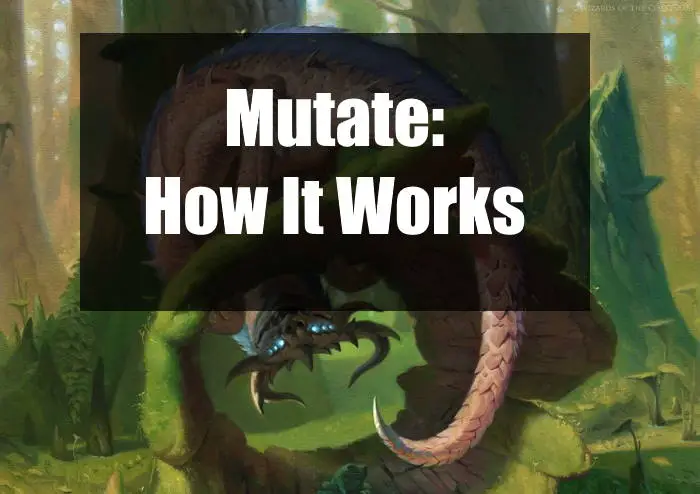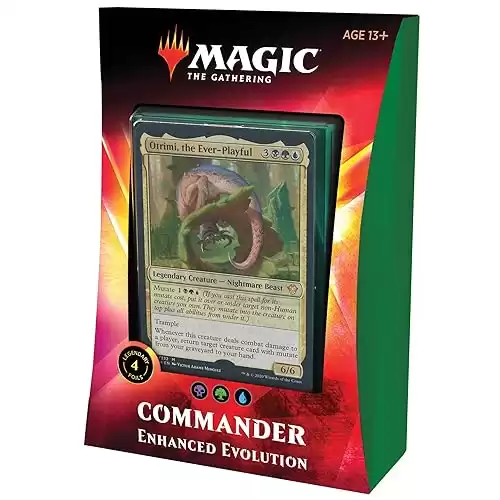Magic has lots of fun, flavorful mechanics as well as complex ones. Mutate is certainly complicated, but it’s also become one of my favorite abilities in MTG. This mechanic represents the constant evolution that happens on Ikoria, so how does it show that through gameplay?
Mutate is an alternative casting cost that shows up on some creatures. When you have a spell with mutate in your hand, you can choose to either cast it normally or cast it for its mutate cost. If you pay the mutate cost, you target a non-human creature you control. Assuming the spell resolves, you merge the two creatures together and put one of them on top of the other. Most of the merged creature’s characteristics come from the creature on top of the stack, but it has the abilities of everything in the mutation.
This process may leave you with a lot of questions, even if you’ve seen mutate cards before. Thankfully, this article will dive into this mechanic and answer some common questions. We’ll also give you some tips on how to build a mutate deck in commander!
Table Of Contents:
- How Does Mutate Work in MTG?
- FAQ
- Is Mutate a Cast Trigger?
- Can You Mutate in MTG without Paying Its Mana Cost?
- Can You Counter Mutate?
- What Happens to a Mutate Spell with an Illegal Target?
- How Many Times Can You Mutate in MTG?
- What Happens When a Mutated Creature Leaves the Battlefield?
- How Does Mutate Work with Transform in MTG?
- How Does Mutate Work with Morph in MTG?
- How Does Mutate Work with Commander Damage/Tax?
- Which MTG Commanders Make the Best Mutate Deck?
- End Step
| Pros | Cons |
| Lets you “upgrade” creatures | Removal can blow you out |
| Still resolves with illegal targets |
How Does Mutate Work in MTG?
Mutate can be hard to wrap your head around. It lets you build your own unique creatures, but understanding how you do so can be tricky. Don’t worry, though! We’re going to break down this mechanic step by step so you can use it with confidence.
Casting a Spell with Mutate
First, you need to be able to cast a spell with mutate. If you can, you can choose to cast it for its mutate cost. This is an alternative casting cost which means:
“You may pay [cost] rather than pay this spell’s mana cost. If you do, it becomes a mutating creature spell and targets a non-Human creature with the same owner as this spell.” (702.140a)
MTG Wiki
Once the spell resolves, it merges with the target creature and becomes a mutated permanent. To represent this, stack together all of the cards and/or tokens that are a part of the new creature.
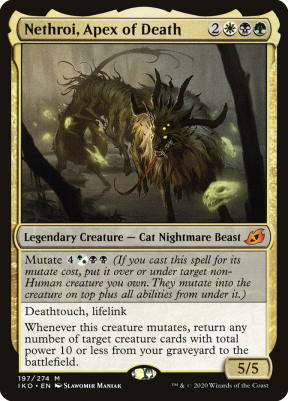
You’ll also choose whether you want the resolving spell to be on top or not. This decision is important because most of the creature’s characteristics will come from its topmost card. This includes its name, colors, power, toughness, mana value, and types.
If you’re mutating another creature onto a permanent that has already been mutated, you again choose whether or not the resolving spell will be on top. You cannot choose any of the other cards or tokens to be on top if they aren’t already.
Mutated Creatures on the Battlefield
Of course, one of the benefits of mutating is that the new creature has all of the abilites of its parts. For example, let’s say you mutated a Baleful Strix with a Majestic Auricorn, putting the latter on top. You would now have a 4/4 creature with flying, deathtouch, and vigilance. It doesn’t take much to create a powerhouse, especially since mutated creatures also have the activated and triggered abilities of their parts.

It’s also worth noting that a mutated permanent doesn’t enter the battlefield. I’ve been using the term “new creature,” but the game sees it as the same object as the original creature. This means that any counters or attached cards will remain. It also means that the mutated creature wouldn’t have summoning sickness, assuming the original creature didn’t.
723.2b As an object merges with a permanent, that object leaves its previous zone and becomes part of an object on the battlefield, but the resulting permanent isn’t considered to have just entered the battlefield.
MTG Wiki
FAQ
Even if you understand the basics, mutate has lots of nuances in how it works. Let’s explore some of the most common questions surrounding this complex mechanic.
Is Mutate a Cast Trigger?
No. Mutate is an alternative casting cost. Nothing inherent to the mutate card will trigger when you cast it.
Can You Mutate in MTG without Paying Its Mana Cost?
No. Only one alternative casting cost can be applied at a time. If an effect would let you cast a spell for free, such as Omniscience, you have to choose between that effect or mutating it.
Can You Counter Mutate?
Yes! You’re still casting a spell when you pay the mutate cost, so counterspells still work.

What Happens to a Mutate Spell with an Illegal Target?
Usually, a spell doesn’t resolve if its target becomes illegal. However, this isn’t the case for mutate:
702.140b As a mutating creature spell begins resolving, if its target is illegal, it ceases to be a mutating creature spell and continues resolving as a creature spell and will be put onto the battlefield under the control of the spell’s controller.
MTG Wiki
This rule gives you some security when you attempt to mutate a creature. If your opponent removes the target, or the target gains protection from the spell’s color, you still get the creature. That creature would the battlefield as normal, and you wouldn’t trigger its abilities that rely on mutating.
How Many Times Can You Mutate in MTG?
There’s no limit to how many times you can mutate. In fact, some cards like Insatiable Hemophage encourage you to mutate as many times as you can!
It can often be worth it to mutate onto the same creature over and over. After all, almost every creature with mutate has an ability that triggers from mutating again. If you’re getting three or four effects from casting one spell, it can be difficult for your opponents to keep up. Even if you aren’t improving the stats of your creature, the value you would generate might be worth it.
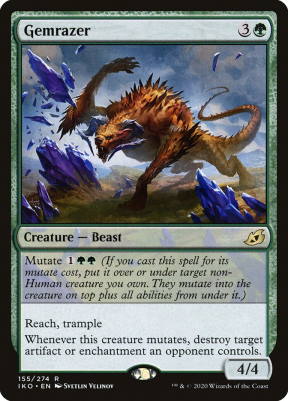
What Happens When a Mutated Creature Leaves the Battlefield?
Even though you might get lots of value, it’s risky to mutate the same creature over and over. Because a mutated permanent is still just one creature, a removal spell can destroy the whole thing.
723.3. If a merged permanent leaves the battlefield, one permanent leaves the battlefield and each of the individual components are put into the appropriate zone.
MTG Wiki
If your opponent casts Murder on your mutated creature, you lose all the cards you put into it. The same goes for bounce spells, exile spells, etc. This can lead to huge blowouts where your opponent trades one of their cards for two, three, or even more of yours. Unless you can protect your creature, you should be careful about putting all your eggs into one basket.
RELATED: MTG Shroud vs Hexproof: Which Is Better?
However, you can use this rule to your advantage. If you blink or flicker a mutated creature, you’ll exile that permanent. Then, each card will return to the battlefield on its own. You can use this to catch your opponents off-guard and have a much stronger
You should also note how this rule works with commanders. If your commander is part of a mutated permanent, it can still return to the command zone. Remember: “Each of the individual components are put into the appropriate zone.” They could all go to the same zone, but some effects might cause them to go to different zones. You can still choose to put your commander in the graveyard, but you don’t have to.
How Does Mutate Work with Transform in MTG?
Mixing mutate with other MTG mechanics can make things even stranger. For example, how does a permanent with both transform and mutate work? It’s not as complicated as you might think:
723.2i If a merged permanent contains one or more transforming double-faced cards (see rule 712), transforming that permanent causes each of those double-faced cards to turn so that its other face is up.
MTG Wiki
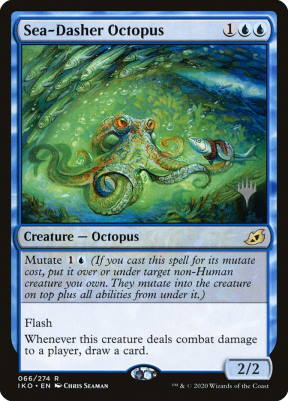
Basically, if you have one card with transform in a mutated permanent, you’ll still be able to transform it. You’ll turn the other side of that card to the correct face, and leave the rest of the permanent as it was. Notably, this doesn’t change which card is on top.
How Does Mutate Work with Morph in MTG?
Morph is another tricky mechanic to use with mutate. Let’s take a last look at the official rules to understand how the two work together:
723.2e If a merged permanent contains face-up and face-down components, the permanent’s status is determined by its topmost component. If a face-down permanent becomes a face-up permanent as a result of an object merging with it, other effects don’t count it as being turned face up.
MTG Wiki
If you had a face-down creature, you could still mutate onto it. What’s important to consider is if you want to flip that creature up later. If you do, you’ll need to put keep the face-down card on top. Otherwise, the whole permanent will be face-up, and you won’t be able to activate any morph abilities.
If you don’t care about using its morph ability, you can just put the face-down creature on the bottom. You’ll likely get better stats this way, but you’ll lose out on potential value late in the game.
How Does Mutate Work with Commander Damage/Tax?
The short answer for both is that they work the same as they always did.
Let’s say that your commander is Bruenor Battlehammer and you mutate it with Cubwarden. Whether Bruenor is on top or not, the mutated permanent still includes him. Therefore, that permanent is still your commander and can deal commander damage just like before.
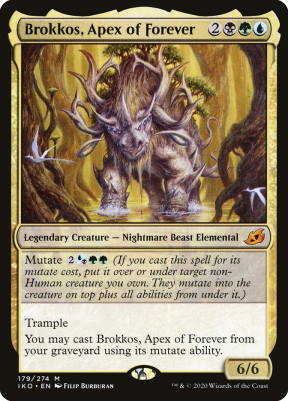
If your commander has mutate, you can’t dodge commander tax by only mutating with it. You’ll still have to pay two extra mana for every time you’ve cast it from the command zone. Since mutating is a casting cost, this includes any times you’ve mutated it.
Which MTG Commanders Make the Best Mutate Deck?
You can use just about any commander for any theme, but some are clearly geared for certain strategies. If you’re looking for commanders that lend themselves to mutate, here are our picks:
Brokos, Apex of Forever // Otrimi, the Ever-Playful
These are probably the most obvious choices. Otrimi was the face commander for the mutate precon, and Brokos is another legendary option in Sultai.
RELATED: The Best Precon Commander Decks
Between the two, I would give a slight edge to Brokos. Otrimi can come out a turn earlier, but Brokos will be a more consistent way to mutate. If you keep him in the graveyard, you can continue to cast him for five mana instead of paying tax. No matter which option you pick, Sultai has the most options for mutate cards, as well as the best effects.
Illuna, Apex of Wishes
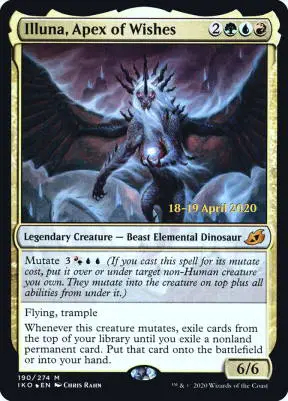
Illuna is another strong option if you want to make a splashy, Timmy deck. Not only is Illuna a big beater, it also gives you a ton of value with each mutate. Cheating permanents into play is exceptionally strong, and it gets even better if you can control the top of your deck.
Losing black to gain red isn’t the best for mutate, though. Not only do you have fewer cards available, you also lose great options like Mindleecher and Dirge Bat. This deck likely will run a few of the best simic mutate cards and just a couple of red ones.
End Step
We’ve covered a lot of information in this article. Feel free to reread any sections that you still need to brush up on: this mechanic is tricky! Still, it’s a favorite of mine, and I think anyone that loves creatures can find some joy in playing with it.
